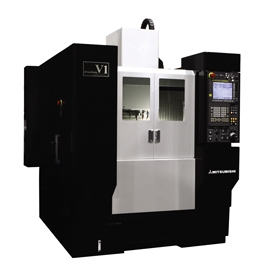Press Information
MHI's "microV1" Micro Milling Machine Achieves Machining
Of 4 Difficult-to-Cut Wafer Materials, Including SiC and Sapphire
-- Production Time and Cost Reduced by Eliminating Photomask Process --
Of 4 Difficult-to-Cut Wafer Materials, Including SiC and Sapphire
-- Production Time and Cost Reduced by Eliminating Photomask Process --
Tokyo, July 7, 2011 - Mitsubishi Heavy Industries, Ltd. (MHI) has successfully machined four types of extremely hard, difficult-to-cut wafer materials, including silicon carbide (SiC) and sapphire, using the company's "µV1" (micro V1) micro milling machine. The µV1 is able to create grooves and grids with 1 micrometer (µM, 0.001 millimeter) level accuracy on wafers by a cutting process only: i.e. without various additional processes that are necessary when creating grooves and grids by photolithography* or etching, thus enabling significant reductions in production time and cost. MHI looks to expand sales of the µV1 as the most suitable machine and technology for trial machining of semiconductor materials and sample production.

For machining of wafer materials, the µV1 uses a cutting tool made of diamond. To remove hard fine swarf mixed with coolant oil, the machine is equipped with a special fine swarf collection filter. The company's proprietary Optical Image-type Tool Measurement System can accurately measure the position of the rotating tool end using a CCD (charge-coupled device) camera, thereby enabling real-time monitoring of tool tip position precisely. This feature lets the machine obtain tool rotation dynamic accuracy data and offset thermal displacement caused by the heat generated by the machine itself, ensuring precise cutting of grooves with 1µM level accuracy.
The µV1 was released in 2006 as a three-axis milling machine for machining of precise die and mold, electrodes as well as precision parts. In 2008, a five-axis model, which has table tilting function with rotary axes, was added to the series. To date applications of the µV1 have been expanded to include machining of nonferrous materials and production of small-sized jigs.
When photolithography or etching is used for semiconductor shaping in trial or sample production – applications in which production quantities are inherently limited and production is subject to frequent changes - these methods tend to inflate costs as they require the production of multiple masks for each modification in semiconductor shape. These methods also require long time for processing patterns in case of deep shape, and they impose limitations on 3D free-curve shape processing. MHI views machining by the µV1 as a new technology that addresses these shortcomings, and the company is aiming at additional applications such as micro flow channels required for bio-chips. To promote use of the machine in those new fields, MHI will leverage its machining knowhow and expertise to firmly support potential users in all phases from initial consideration of the µV1 through to its actual operation.
The machined samples of the four difficult-to-cut wafer materials and a video of the µV1 in action will be presented at "Exhibition Micromachine/MEMS 2011," which is to take place at Tokyo Big Sight on July 13-15. Through this exhibition, MHI will propose new applications of the µV1 to potential customers as a way of adding momentum to the machine's further sales expansion.
Note:
Photolithography is a method for creating a pattern on a substrate by radiating light through a patterned photomask onto a substrate coated with a light-sensitive chemical (resist). After exposure, the resist exposed to the light hardens. During etching, the surface area unprotected by the hardened resist resolves into a chemical liquid. Photolithography requires multiple processes including preparation, resist application, exposure, etching, removal and cleaning.
Products Page
About MHI Group
Mitsubishi Heavy Industries (MHI) Group is one of the world’s leading industrial groups, spanning energy, smart infrastructure, industrial machinery, aerospace and defense. MHI Group combines cutting-edge technology with deep experience to deliver innovative, integrated solutions that help to realize a carbon neutral world, improve the quality of life and ensure a safer world. For more information, please visit www.mhi.com or follow our insights and stories on spectra.mhi.com.






